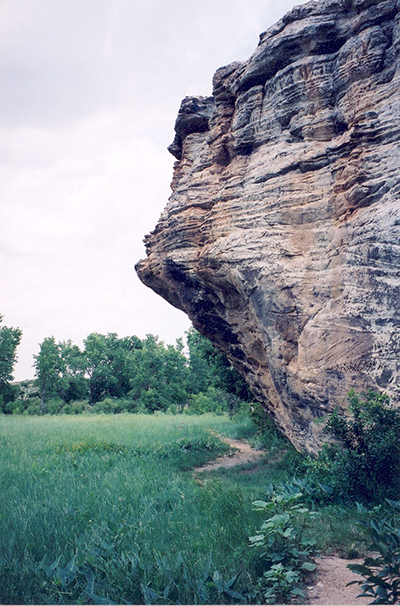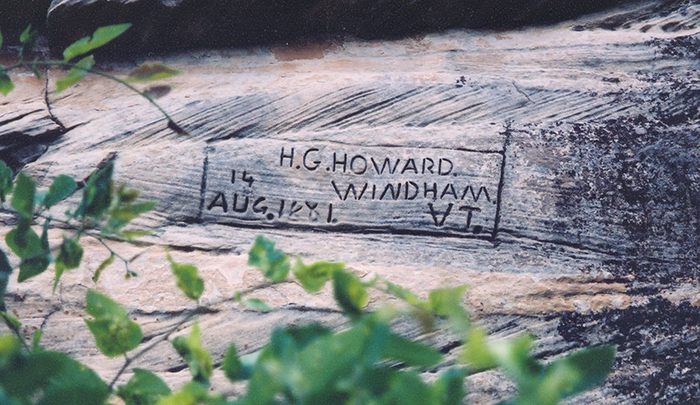SANTA FE TRAIL.
A major western commercial route, the Santa Fe Trail stretched some nine hundred miles from Franklin, Missouri, to Santa Fe, New Mexico. Established in 1821 when William Becknell took a pack train from Missouri to Santa Fe, the trail operated until the Atchison, Topeka and Santa Fe Railway built into New Mexico in 1880. The trail consisted of two distinctly different routes and a number of short variations. The Mountain Route, used by Becknell's 1821 pack train, followed the Arkansas River through Kansas to near present Trinidad, Colorado, crossed the mountains through Raton Pass into New Mexico, and then skirted the foothills of the Rocky Mountains until finally arriving at Santa Fe. The Cimarron Route or Cimarron Cutoff, used by Becknell in 1822 when he took the first wagon train to New Mexico, was destined to carry approximately 75 percent of the traffic along the trail. It followed the Mountain Route until it reached the Great Bend of the Arkansas River, at which point it turned southwesterly to traverse present Cimarron County in the Oklahoma Panhandle and northeastern New Mexico, rejoining the Mountain Route near Watrous.
The Cimarron Route was shorter and more suited to wagon travel, and it shortened the traveling time by ten days. However, it was considered much more dangerous than the Mountain Route due to the shortage of water and the danger of Indian attack. Depending upon where the trail left the Arkansas, it was a journey of fifty or more miles to reach the next reliable water, at the Cimarron River. This stretch, called the jornada, was a much-dreaded, waterless area. Upon reaching the Cimarron, the trail followed that river into present Cimarron County, Oklahoma, crossed the river at Willowbar Crossing, and continued southwesterly to Cold Springs. There Autograph Rock (on private land) still displays the names that scores of travelers carved into the ledges at the springs. This permanent water source was considered to be a major stopping point on the journey. Here the wagons were repaired and the livestock was rested before continuing. The jornada danger was not relieved until 1850 when Francis X. Aubry opened a better watered, although slightly longer, alternate route that left the Arkansas further west near present Syracuse, Kansas. The Aubry Cutoff joined the original trail at Cold Springs and continued on past Camp Nichols. That short-lived military post, established by Christopher "Kit" Carson in 1865, holds the distinction of being the only military establishment on the Santa Fe Trail in Oklahoma. The trail finally exited the state from the southwestern portion of Cimarron County into Union County, New Mexico. Lying in the heart of the Kiowa and Comanche homeland, the fifty or sixty miles across the Oklahoma Panhandle were believed to be the most dangerous stretch of the trail. During various times of Indian unrest the U.S. Army was forced to provide escort to travelers crossing this region.
The volume of travel along the trail was tremendous for a frontier region. Varying from a few hundred wagons of traders each year in the 1820s, the volume swelled to several thousand annually in the late 1840s, due to activities surrounding the Mexican War and the California gold rush. By the end of the Civil War in 1865 the Santa Fe Trail had provided the access that opened up the Southwest to Anglo-American settlement and made No Man's Land, the future Oklahoma Panhandle, much better known to a wide range of people.
Learn More
William E. Brown, The Santa Fe Trail (St. Louis, Mo.: Patrice Press, 1988).
Seymour V. Connor and Jimmy M. Skaggs, Broadcloth and Britches: The Santa Fe Trade (College Station: Texas A&M University Press, 1977).
Robert L. Duffus, The Santa Fe Trail (New York. Longmans, Green and Co., 1931).
Marc Simmons, ed., On the Santa Fe Trail (Lawrence: University Press of Kansas, 1986).
Citation
The following (as per The Chicago Manual of Style, 17th edition) is the preferred citation for articles:
Bobby D. Weaver, “Santa Fe Trail,” The Encyclopedia of Oklahoma History and Culture, https://www.okhistory.org/publications/enc/entry?entry=SA020.
Published January 15, 2010
© Oklahoma Historical Society



